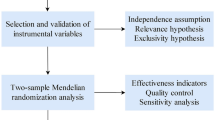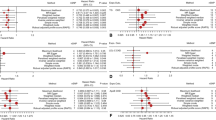Abstract
The complement system is activated during the development of nonalcoholic fatty liver disease (NAFLD). We aimed to evaluate the causal relationship between serum C3 and C4 levels and NAFLD. After exclusion criteria, a total of 1600 Chinese Han men from the Fangchenggang Area Male Health and Examination Survey cohort were enrolled in cross-sectional analysis, while 572 participants were included in the longitudinal analysis (average follow-up of 4 years). We performed a bidirectional Mendelian randomization (MR) analysis using two C3-related, eight C4-related and three NAFLD-related gene loci as instrumental variables to evaluate the causal associations between C3, C4, and NAFLD risk in cross-sectional analysis. Per SD increase in C3 levels was significantly associated with higher risk of NAFLD (OR = 1.65, 95% CI 1.40, 1.94) in cross-sectional analysis while C4 was not (OR = 1.04, 95% CI 0.89, 1.21). Longitudinal analysis produced similar results (HRC3 = 1.20, 95% CI 1.02, 1.42; HRC4 = 1.10, 95% CI 0.94, 1.28). In MR analysis, there were no causal relationships for genetically determined C3 levels and NAFLD risk using unweighted or weighted GRS_C3 (βE_unweighted = −0.019, 95% CI −0.019, −0.019, p = 0.202; βE_weighted = −0.019, 95% CI −0.019, −0.019, p = 0.322). Conversely, serum C3 levels were significantly effected by the genetically determined NAFLD (βE_unweighted = 0.020, 95% CI 0.020, 0.020, p = 0.004; βE_weighted = 0.021, 95% CI 0.020, 0.021, p = 0.004). Neither the direction from C4 to NAFLD nor the one from NAFLD to C4 showed significant association. Our results support that the change in serum C3 levels but not C4 levels might be caused by NAFLD in Chinese Han men.


Similar content being viewed by others
References
Bugdaci MS, Karaca C, Alkim C, Kesici B, Bayraktar B, Sokmen M (2012) Serum complement C4 in chronic hepatitis C: correlation with histopathologic findings and disease activity. Turk J Gastroenterol 23(1):33–37. https://doi.org/10.4318/tjg.2012.0310
Chaibub Neto E, Keller MP, Attie AD, Yandell BS (2010) Causal graphical models in systems genetics: a unified framework for joint inference of causal network and genetic architecture for correlated phenotypes. Annals Appl Stat 4(1):320–339. https://doi.org/10.1214/09-aoas288
Chalasani N, Younossi Z, Lavine JE, Charlton M, Cusi K, Rinella M et al (2018) The diagnosis and management of nonalcoholic fatty liver disease: practice guidance from the American Association for the Study of Liver Diseases. Hepatology 67(1):328–357. https://doi.org/10.1002/hep.29367
Friedman SL, Neuschwander-Tetri BA, Rinella M, Sanyal AJ (2018) Mechanisms of NAFLD development and therapeutic strategies. Nat Med 24(7):908–922. https://doi.org/10.1038/s41591-018-0104-9
Gao B, Jeong WI, Tian Z (2008) Liver: an organ with predominant innate immunity. Hepatology 47(2):729–736. https://doi.org/10.1002/hep.22034
Haycock PC, Burgess S, Wade KH, Bowden J, Relton C, Davey Smith G (2016) Best (but oft-forgotten) practices: the design, analysis, and interpretation of Mendelian randomization studies. Am J Clin Nutr 103(4):965–978. https://doi.org/10.3945/ajcn.115.118216
He M, Wu C, Xu J, Guo H, Yang H, Zhang X et al (2014) A genome wide association study of genetic loci that influence tumour biomarkers cancer antigen 19–9, carcinoembryonic antigen and alpha fetoprotein and their associations with cancer risk. Gut 63(1):143–151. https://doi.org/10.1136/gutjnl-2012-303434
Hu K-Q (2002) Occult hepatitis B virus infection and its clinical implications. J Viral Hepatitis 9(4):243–257. https://doi.org/10.1046/j.1365-2893.2002.00344.x
Jia Q, Li C, Xia Y, Zhang Q, Wu H, Du H et al (2015) Association between complement C3 and prevalence of fatty liver disease in an adult population: a cross-sectional study from the Tianjin Chronic Low-Grade Systemic Inflammation and Health (TCLSIHealth) cohort study. PLoS ONE 10(4):e0122026. https://doi.org/10.1371/journal.pone.0122026
Jiang DK, Ma XP, Yu H, Cao G, Ding DL, Chen H et al (2015) Genetic variants in five novel loci including CFB and CD40 predispose to chronic hepatitis B. Hepatology 62(1):118–128. https://doi.org/10.1002/hep.27794
Kitamoto T, Kitamoto A, Yoneda M, Hyogo H, Ochi H, Nakamura T et al (2013) Genome-wide scan revealed that polymorphisms in the PNPLA3, SAMM50, and PARVB genes are associated with development and progression of nonalcoholic fatty liver disease in Japan. Hum Genet 132(7):783–792. https://doi.org/10.1007/s00439-013-1294-3
Lawlor DA, Harbord RM, Sterne JA, Timpson N, Davey Smith G (2008) Mendelian randomization: using genes as instruments for making causal inferences in epidemiology. Stat Med 27(8):1133–1163. https://doi.org/10.1002/sim.3034
Lee YH, Kim SU, Song K, Park JY, Kim DY, Ahn SH et al (2016) Sarcopenia is associated with significant liver fibrosis independently of obesity and insulin resistance in nonalcoholic fatty liver disease: Nationwide surveys (KNHANES 2008–2011). Hepatology 63(3):776–786. https://doi.org/10.1002/hep.28376
Lin YC, Chang PF, Chang MH, Ni YH (2014) Genetic variants in GCKR and PNPLA3 confer susceptibility to nonalcoholic fatty liver disease in obese individuals. Am J Clin Nutr 99(4):869–874. https://doi.org/10.3945/ajcn.113.079749
Liu Z, Tang Q, Wen J, Tang Y, Huang D, Huang Y et al (2016) Elevated serum complement factors 3 and 4 are strong inflammatory markers of the metabolic syndrome development: a longitudinal cohort study. Sci Rep 6:18713. https://doi.org/10.1038/srep18713
Luk AO, So WY, Ma RC, Kong AP, Ozaki R, Ng VS et al (2008) Metabolic syndrome predicts new onset of chronic kidney disease in 5,829 patients with type 2 diabetes: a 5-year prospective analysis of the Hong Kong Diabetes Registry. Diabetes Care 31(12):2357–2361. https://doi.org/10.2337/dc08-0971
Macaluso FS, Maida M, Petta S (2015) Genetic background in nonalcoholic fatty liver disease: a comprehensive review. World J Gastroenterol 21(39):11088–11111. https://doi.org/10.3748/wjg.v21.i39.11088
Phillips AN, Smith GD (1991) How independent are “independent” effects? relative risk estimation when correlated exposures are measured imprecisely. J Clin Epidemiol 44(11):1223–1231. https://doi.org/10.1016/0895-4356(91)90155-3
Pierce BL, Ahsan H, Vanderweele TJ (2011) Power and instrument strength requirements for Mendelian randomization studies using multiple genetic variants. Int J Epidemiol 40(3):740–752. https://doi.org/10.1093/ije/dyq1511
Pritchard MT, McMullen MR, Stavitsky AB, Cohen JI, Lin F, Edward Medof M et al (2007) Differential contributions of C3, C5, and decay-accelerating factor to ethanol-induced fatty liver in mice. Gastroenterology 132(3):1117–1126. https://doi.org/10.1053/j.gastro.2007.01.053
Rensen SS, Slaats Y, Driessen A, Peutz-Kootstra CJ, Nijhuis J, Steffensen R et al (2009) Activation of the complement system in human nonalcoholic fatty liver disease. Hepatology 50(6):1809–1817. https://doi.org/10.1002/hep.23228
Segers FM, Verdam FJ, de Jonge C, Boonen B, Driessen A, Shiri-Sverdlov R et al (2014) Complement alternative pathway activation in human nonalcoholic steatohepatitis. PLoS ONE 9(10):e110053. https://doi.org/10.1371/journal.pone.0110053
Sinn DH, Kang D, Jang HR, Gu S, Cho SJ, Paik SW et al (2017) Development of chronic kidney disease in patients with non-alcoholic fatty liver disease: a cohort study. J Hepatol 67(6):1274–1280. https://doi.org/10.1016/j.jhep.2017.08.024
Smith GD, Ebrahim S (2002) Data dredging, bias, or confounding. BMJ 325(7378):1437–1438. https://doi.org/10.1136/bmj.325.7378.1437
Tan A, Gao Y, Yang X, Zhang H, Qin X, Mo L et al (2011) Low serum osteocalcin level is a potential marker for metabolic syndrome: results from a Chinese male population survey. Metabolism 60(8):1186–1192. https://doi.org/10.1016/j.metabol.2011.01.002
Tian GX, Sun Y, Pang CJ, Tan AH, Gao Y, Zhang HY et al (2012) Oestradiol is a protective factor for non-alcoholic fatty liver disease in healthy men. Obes Rev 13(4):381–387. https://doi.org/10.1111/j.1467-789X.2011.00978.x
Ursini F, Russo E, Mauro D, Abenavoli L, Ammerata G, Serrao A et al (2017) Complement C3 and fatty liver disease in Rheumatoid arthritis patients: a cross-sectional study. Eur J Clin Invest 47(10):728–735. https://doi.org/10.1111/eci.12798
van Greevenbroek MM, Jacobs M, van der Kallen CJ, Vermeulen VM, Jansen EH, Schalkwijk CG et al (2011) The cross-sectional association between insulin resistance and circulating complement C3 is partly explained by plasma alanine aminotransferase, independent of central obesity and general inflammation (the CODAM study). Eur J Clin Invest 41(4):372–379. https://doi.org/10.1111/j.1365-2362.2010.02418.x
Wang X, Liu Z, Wang K, Wang Z, Sun X, Zhong L et al (2016) Additive effects of the risk alleles of PNPLA3 and TM6SF2 on non-alcoholic fatty liver disease (NAFLD) in a Chinese Population. Front Genet 7:140. https://doi.org/10.3389/fgene.2016.00140
Wang F, Wang J, Li Y, Yuan J, Yao P, Wei S et al (2018a) Gallstone disease and type 2 diabetes risk: a Mendelian randomization study. Hepatology. https://doi.org/10.1002/hep.30403
Wang N, Chen C, Zhao L, Chen Y, Han B, Xia F et al (2018b) Vitamin D and nonalcoholic fatty liver disease: bi-directional mendelian randomization analysis. EBioMedicine 28:187–193. https://doi.org/10.1016/j.ebiom.2017.12.027
Wlazlo N, van Greevenbroek MM, Ferreira I, Jansen EH, Feskens EJ, van der Kallen CJ et al (2013) Activated complement factor 3 is associated with liver fat and liver enzymes: the CODAM study. Eur J Clin Invest 43(7):679–688. https://doi.org/10.1111/eci.12093
Xu C, Chen Y, Xu L, Miao M, Li YYuC (2016) Serum complement C3 levels are associated with nonalcoholic fatty liver disease independently of metabolic features in Chinese population. Sci Rep 6:23279. https://doi.org/10.1038/srep23279
Yang X, Sun J, Gao Y, Tan A, Zhang H, Hu Y et al (2012) Genome-wide association study for serum complement C3 and C4 levels in healthy Chinese subjects. PLoS Genet 8(9):e1002916. https://doi.org/10.1371/journal.pgen.1002916
Younossi ZM, Koenig AB, Abdelatif D, Fazel Y, Henry L, Wymer M (2016) Global epidemiology of nonalcoholic fatty liver disease—meta-analytic assessment of prevalence, incidence, and outcomes. Hepatology 64(1):73–84. https://doi.org/10.1002/hep.28431
Younossi Z, Tacke F, Arrese M, Chander Sharma B, Mostafa I, Bugianesi E et al (2019) Global perspectives on nonalcoholic fatty liver disease and nonalcoholic steatohepatitis. Hepatology 69(6):2672–2682. https://doi.org/10.1002/hep.30251
Acknowledgements
We thank the local research team from Fangchenggang First People’s Hospital for their contribution to the recruitment of study subjects. We thank XZ, HZ, and OL at the Genergy Biotechnology (Shanghai) Co., Ltd., for their assistance in the genotyping. Finally, we thank all study subjects for participating in this study.
Author information
Authors and Affiliations
Corresponding author
Ethics declarations
Conflict of interest
The authors declare that they have no conflict of interest.
Availability of data and material
The datasets analyzed during the current study are available from the corresponding author upon reasonable request
Code availability
Not applicable.
Authors' contributions
LL and YX designed the study. MZ, ZH, and YX coordinated the study and oversaw participant recruitment, collection, and analysis of biological samples. LL and HL conducted the statistical analyses. LL drafted the paper, which was reviewed by all authors. All authors approved the final version of the article, including the authorship list.
Funding
This work was supported by the Guangxi Natural Science Fund for Innovation Research Team [2017GXNSFGA198003], Key projects of strategic international scientific and technological innovation cooperation of the Chinese Ministry of Science and Technology [2020YFE0201600], and Guangxi key Laboratory for Genomic and Personalized Medicine [19-185-33, 20-065-33].
Ethics approval
The study was approved by the Ethics and Human Subject Committee of Guangxi Medical University.
Consent to participate
Informed consent was obtained from all individual participants included in the study.
Consent to publication
Not applicable.
Supplementary Information
Below is the link to the electronic supplementary material.
Rights and permissions
About this article
Cite this article
Li, L., Huang, L., Yang, A. et al. Causal Relationship Between Complement C3, C4, and Nonalcoholic Fatty Liver Disease: Bidirectional Mendelian Randomization Analysis. Phenomics 1, 211–221 (2021). https://doi.org/10.1007/s43657-021-00023-0
Received:
Revised:
Accepted:
Published:
Issue Date:
DOI: https://doi.org/10.1007/s43657-021-00023-0




